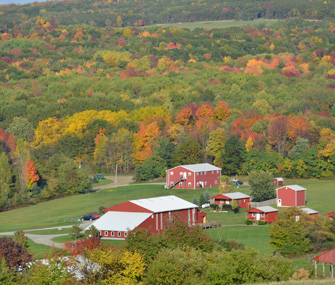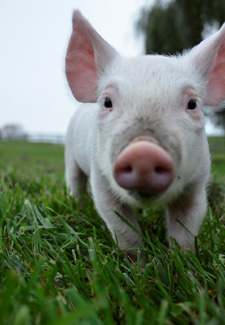Sanctuary Offers Refuge to Rescued Farm Animals
Published on September 08, 2014

How much do you know about the farm animals providing your eggs, milk and meat? Do you know how they live or what their personalities are like? Unfortunately, many people don’t know much about the farm animals living in our country. In honor of National Farm Animals Awareness Week (September 14 to 20), we take a look at Farm Sanctuary, an organization trying to increase awareness about such animals.
Farm Sanctuary was founded in 1986 with a mission to combat factory farming and help protect farm animals from cruelty. Its members work to inform the public about how the animals are treated and to convey an understanding of their intelligence, emotions and behavior. Farm Sanctuary co-founder Gene Baur says that when Farm Sanctuary started, there was little awareness about the way animals in production systems were being treated, so the organization began to document conditions.
“We’d find living animals left for dead, so we started rescuing them,” he says. “Our shelter operations began, and we realized it was also important to educate people so that [they] could start making choices that did not support this kind of abusive system, and we continue doing that.”
Rescuing Farm Animals
Farm Sanctuary rescues animals hurt by factory farming. Factory farming refers to the practice of raising animals in high-density confinement to maximize profits, often using abusive practices and sacrificing animal welfare and the environment to reach that goal. Baur says these farms often raise thousands of animals in terrible conditions, and when an animal’s health starts to decline, the animal is often discarded. The sanctuary becomes aware of these animals a number of ways, including being contacted by people who work at the farms and neighbors who see animals being mistreated or denied basic care. Farm Sanctuary also takes in animals affected by disasters, such as floods that wash them out of barns or storms that knock barns down. Animals who get free while being transported or who are involved in car accidents and need help are also brought to the group.
Farm Sanctuary National Shelter Director Susie Coston usually goes on the animal rescues. Coston says that unless it’s just one animal, a team is typically assembled for a rescue. She is often the one to make sure animals are healthy enough for travel before they are transported to one of three sanctuaries.
Life at the Sanctuaries
Coston has worked for Farm Sanctuary for 14 years and oversees its animal sanctuaries. She spends a lot of her time at the largest, in Watkins Glen in New York, but she often travels to the other two, which are in California. According to Coston, what makes the sanctuaries unique is the individual care given to animals. Each animal’s health issues are documented on her own chart. This personal attention is something these animals do not receive in the larger factory farm system.

Combined, the sanctuaries are home to more than 1,000 animals, with a team to care for them:
- A morning health care person works from about 6 a.m. to 3 p.m., giving animals their medication twice a day.
- An afternoon/evening health care worker arrives at noon and stays until about 9 p.m. and gives nighttime medications.
- Two others work during the day to assist with anything that requires more than one set of hands, such as wrapping large wounds.
- Other workers help feed the animals and handle the day-to-day business of the farm.
At the sanctuaries, animals have space and comfortable surroundings. They can roam open pastures and spend time with their fellow animals.
“At Farm Sanctuary, the animals are our friends, not our food. … The animals get to be who they are,” Baur says. “They’re provided with a healthy environment, with nurturing food and with veterinary care when they need it.”
Animal Personalities
If you visit these sanctuaries and interact with the animals, you might be surprised by what you see. How these animals act might remind you of your pets.
“Most people think that, for example, sheep are easily frightened, but sheep are friendly and run up to people,” Coston says. “The animals also learn their names — even chickens. If you call an animal a name on a regular basis, she learns it.”
According to Coston, people are especially surprised to see this behavior in birds. She says people are inclined to relate to mammals more, but birds are very social and friendly and are capable of doing things most people picture cats and dogs doing.
“Farm animals are not that different from cats and dogs in terms of the fact that they have personalities — they’re individuals. Some are much more outgoing than others, some are more shy and, like all animals, they also respond to how they’re treated,” Baur says. “If they’re constantly abused, they become very fearful, just like a dog or a cat, but they also respond to love.”
Baur sees these animals form relationships, recognize friends and remember the experiences they have.
“They respond to being in a kind environment. They learn to trust again, and that is a very important lesson for everybody,” he says. “That’s something these animals teach us every day at Farm Sanctuary. Like everybody, they just want to live a happy life. They don’t want to be abused. They’re very similar to us, cats and dogs, and all other animals.”
Learn more about Farm Sanctuary and how you can help farm animals on the organization’s website. You can also visit its Facebook page.





